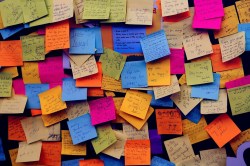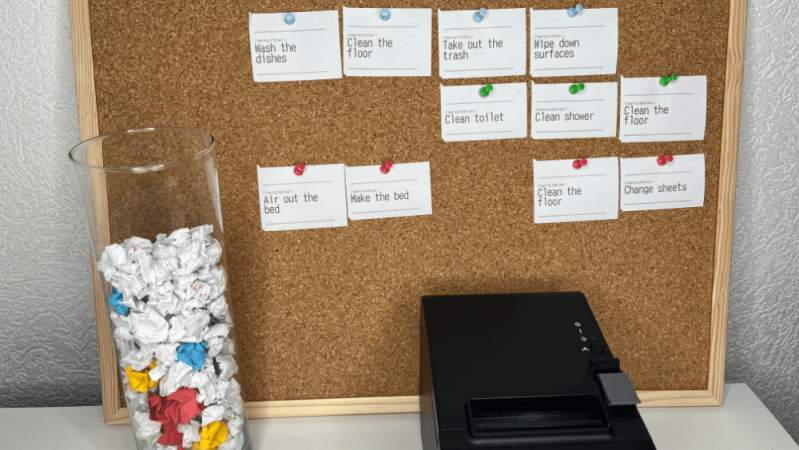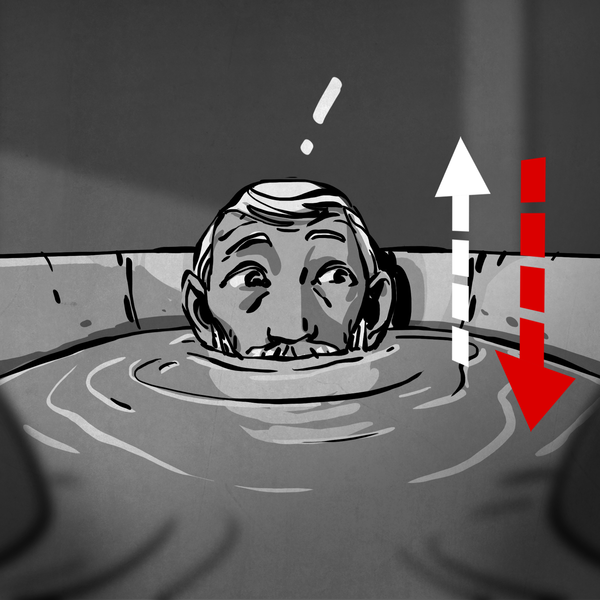No, of course not. Per Betteridge’s law, that’s the answer to any headline with a question mark. On the other hand, while a thermal printer might not cure ADHD, it can help treat it — according to [Laurie Hérault], to the point of curing his procrastination habit. Even if you don’t have ADHD, you probably do procrastinate sometimes, so this hack is worth a look.
The printer itself is a key hardware portion of the hack, but the hack itself is purely organizational. [Laurie] started with post-its before adding automation. Before the post-it notes came a simple realization: [Laurie] could sit and play games for hours, but not buckle down for serious work for more than a few minutes, if he could even get started. (Who can’t relate?) That sent him down a rabbit hole reading about the psychology of what makes games so addictive — and the idea of “gamification” that was so popular in educational circles not long ago.
Unlike work, games give you a loop of unambiguous, instant, and continuous feedback to pump your dopamine circuits. [Laurie] uses the example of an FPS. You aim, you shoot — and either you miss, or you hit the target. Either way, there’s feedback. When you hit, your brain gives you dopamine. This fast loop of input -> feedback is what [Laurie] felt he was missing from his day.

That’s where the post-it notes came in. Post-its went up on a board with all of his tasks for the day; the input was his completing the tasks, and the feedback was taking them down, crumpling them up, and putting them into a clear jar that would serve as a score bar for his productivity. The feedback actually rewarded multiple senses this way: the tactility of crumpling paper, the sound of it, and the visual of the rising level of the jar.
A key insight [Laurie] had in this process is that many productivity apps (including gamifying ones) are focused too much on high-level tasks by default. “Clean the kitchen,” for example. That’s too big! It’s daunting, and it takes too long for that immediate, gamified feedback. Instead [Laurie] breaks down “Cleaning the Kitchen” into “Clean the dishes”, “Wipe the Counter”, “Take out the Trash”, et cetera. The smaller the steps, the more frequent the reward, and the easier it is to start them without exerting much willpower: just like a video game.
Of course writing all of those post-it notes gets tedious, especially for recurring and pre-scheduled tasks, and that tedium increases exponentially when breaking tasks down into the smallest possible chunks. That’s where the thermal printer came in. [Laurie] wrote a simple software utility to allow him to create high-level tasks, and break them down into small action items that are immediately sent to the thermal printer. After that, the system works just as it does with the post-it notes. He promises to share this software, but it does not seem to have yet been released. Hopefully he’s not procrastinating on that, or our faith in the process is ruined.
Thermal printers are great for lifehacks, like this hack for receipt-like mementos, or this one to ease the load on a dungeon master. If you prefer you can skip the ‘life’ part of lifehacks, and just make an instant camera.
















I was going to leave an insightful comment but I got distracted :(
how about ?how the thermal ink is actually bisphenol-a. any long term exposure such as cashier jobs can cause anything from infertitility to cancer .
In the article, he mentions the importance of sourcing BPA-free thermal paper.
Thermal paper is BPS free has been for years
This is the idea behind methods like KanBan, isn’t it? Cool idea to automate a physical represenataion of creating what Jira calls an “issue” (no, I don’t like that name for it). It’s really a nice project, love it!
What I found after we went to hybrid working and moved our Kanboard at work from Post-it notes to an online version the dopamine kick really is lost. The good feeling of ripping a post-it from its current position on the wall and movin it to another status is just absent now. :(
I agree with you that “issue” is not a nice term. Issue implies a problem, but not all work is about solving problems, but can also be improvements. Jira no longer uses that term. They call it a work item now.
Jira now calls them “work items” it seems.
That’s what I wrote.
It seems you wrote that Jira calls them “work items”.
forwardslashess
I agree, physicallity is super-important to get that delicious dopamine. Maybe you could wire up a big red button you can smash to move your task into the next status?
Wouldn’t a “ticket” fit nicely here?
Why not just take a piece of A4 paper, write some bullet points with stuff to do and cross them once they’re done?
Costs $0.008 per page and you don’t have to handle toxic thermal paper.
Why not “just” remember to do the work? Costs nothing.
Not enough dopamine after “just” crossing out stuff and like written in article, writing it all every day is too tedious. But please try it and share the results.
Exactly!
It bothers me so much when people assume that we all function in the same way. Digital to do list works for you? Great! Need paper? Also good! You need post-its or a receipt printer? Glad you found what works!
As someone who struggles MONUMENTALLY with this, it bothers the crap out of me when someone does an article or video with what worked for them, but then implies it’s “the” solution. The reality is that there are a thousand ways to approach task management, and for those of us struggling with ADHD we can try a LOT of things before finding one that works for US, AS AN INDIVIDUAL.
So this person found what works for them. If you don’t need their solution, then it’s not for you, and that’s fine.
Since when did thermal paper become toxic?
Used to be bad for your health with repeated touch (ie people working at cash registers), but in the west (or the US at least) they banned the toxic stuff, problem being that we buy supplies from China though.
Info on wikipedia, or ask an AI to read Wikipedia and tell you, since it seems that is what AI does in more than 40% of the cases I hear. (Problem is the remaining percentage I suppose, Reddit posts needs some brains to filter.)
Phenol free thermal paper has been available for quite a while now. It’s non-toxic and recyclable.
Because he could do all that lovely procrastinating writing the software
Maybe he didn’t include it in tasklist…
Its a surprisingly common failure mode for any system like this.
i was considering what seems like a bizarre technical choice to me, to use a printer for this. on the one hand, a whiteboard could do just as well. and on the other hand, a computer screen can too. (i keep my todo list on PC and sync it to my phone and to an eink wall-hanger)
but then i figured it out
this project was something to do while procrastinating on something else
gonna summarize a great article i read about procrastination…sometimes if you have a large list of tasks that you are procrastinating on, you can make headway on the high-priority tasks by picking the lowest priority of those tasks and doing it, and letting all the higher priority ones go undone for a while
I don’t know, I feel like the article did a pretty good job of explaining exactly why using a printer for this makes sense. It might not be your approach to task management, but I certainly wouldn’t consider it “bizarre.” He wanted the dopamine hit and visual progress indicator provided by being able to physically take down tasks and crumple them up in a jar, while removing the tedium of having to write down repetitive tasks. Receipt printer feels like a perfect solution to that problem set.
I know a few people that use post-it notes religiously for this purpose.
Checking off an electronic copy doesn’t usually achieve the same goal.
(Perhaps if it were significantly more skeuomorphic it could).
It would be interesting to see how to shift this from the physical to the digital world in a way that actually does work for people.
None of this works for me. I’ve tried, and it doesn’t achieve the goal.
i guess i don’t see humans as that simple. being mindful to tasks that need doing and tasks that have been done really does affect behavior, with carrot and stick both present in mad abundance. reasoning about tasks, celebrating completion, prioritizing, gamifying, these are all real powers we have over the human brain.
but if you actually make and do a todo list…man, i hit ‘dd’ in nvi to delete a line, and it feels just as good as crumpling up paper, and doesn’t produce any additional cleanup chores unlike this. are people really so different? i think people who are hung up on the physicality of the reward are people who failed both systems (tangible and intangible) and are grasping at straws for what they might do differently.
anyways if you want a real tangible reward, have a cookie
Short answer: yes, people really are that different.
I had this idea a while back but didn’t have the time or skills to mess with it. I use post-it notes all the time for keeping track of things at work. The dopamine hit from getting to throw away a note is much better than just crossing something off a list.
Exactly that. The physical part of destroying the completed post-it note is very important.
From my point of view: this is a great idea, and I will implement it for my son.
One of my sons suffers ADHD. Even if he has learned to break “big” tasks (for example: clean his room) in smaller ones (clean the room = sort the desktop + sort dirty clothes; sort the desktop = sort the pencils + discards used papers, …), it’s still hard for him. As said in this article, the key point is giving him lots of “reward” as used in reinforcement learning (since it’s pathology brings him lots of negative feedbacks all the day long). That’s one point I’ve learned during my PhD ;)
When not suffering ADHD it’s hard to understand that this is so hard to do. Teachers usually don’t understand why a boy (which is sometime able to understand mathematics better than them) is not able to remember to bring it’s mathematics book for the lesson. But it’s the way he works.
Did your PhD work also have “it’s” where it should be “its”?
OK that was mean, but you should not make such mistakes right before bragging though.
OH and then repeat the mistake later on, dude… “it’s” is short for “it is” or “it has”
If you are so anxious to be correct, why do you assume BadAngel is a dude?
Dude is American slang for an individual, typically male. From the 1870s to the 1960s, dude primarily meant a male person who dressed in an extremely fashionable manner (a dandy) or a conspicuous citified person who was visiting a rural location, a “city slicker”. In the 1960s, dude evolved to mean any male person, a meaning that slipped into mainstream American slang in the 1970s. Current slang retains at least some use of all three of these common meanings.
Regarding the comment you refer to, I cannot say that “That’s one point I’ve learned during my PhD ;)” is to be considered “bragging”. The ;) signals that the comment should not be taken seriously but also the part “That’s one point I’ve learned…” suggests not much was learned at all. Bit of harsh to attack a person based upon the location of a stray ‘ in piece of text that was actually pretty constructive, on-topic and pretty personal and if I’m not mistaken actually the one and only spelling mistake in the entire comment. Which consisted of about 861 characters. Which means that the error rate of this piece of text is about 0.12%, seems pretty accurate to me.
Haven’t read the fine article, but, how does the system know a repetitive task has been thrown in the vase, so it can print another? I’m thinking there should be a unique barcode printed on each one, and a scanner mounted near the printer. Scan to complete. Crumple. Toss. Receive new task at the appropriate time. You could even add deadlines, and get a better score by completing things early.
That would be a fine addition, I think. This system isn’t that smart: a recurring task gets printed on a schedule. If you don’t complete it in time, you get another ticket, which I suppose could be its own form of motivation for some people.
A lot of people with ADHD would find the repeat tickets incredibly demotivating, so your add-on would be very helpful for them, but everybody is different.
This is relevant to my interests. I see thermal printers and rolls of paper showing up at thrift stores quite regularly.